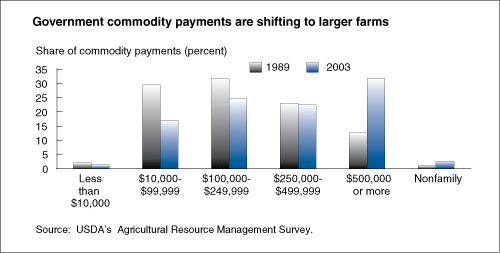Financial Assistance to Farmers is Evolving
- by James M. MacDonald
- 11/1/2005
The U.S. Government has long provided financial assistance to farmers, with payments averaging $17 billion a year since 1999. From the 1930s through the 1950s, assistance largely took the form of commodity supply controls and price supports, which provided assistance by raising the prices that farmers received for their commodities. Today’s payments, like those of the past, are mostly commodity based, but assistance has steadily shifted away from price supports and toward payments made directly to farmers.
Several key farm attributes drive the amount of commodity-based assistance received by farmers. Those attributes include land ownership and tenure, as well as current and past production of eligible commodities. But other broad factors also affect how assistance is distributed among households. In particular, major ongoing changes in farming are transforming how payments are distributed among farms and the links between incomes and assistance.
In the early days of farm programs, average farm household incomes fell well below household incomes for the rest of the population. Few farmers worked off the farm, very few held full-time off-farm jobs, and individual farms produced a variety of crops and livestock. Assistance targeted at the production of eligible crops consequently flowed to many farms, and largely went to low- and middle-income households.
The economic status of farm households is much different now. Over half of farm operators hold off-farm jobs, and, among these, 70 percent hold full-time jobs, most while maintaining a limited farming operation. Average farm household incomes match or exceed incomes for other U.S. households, and the incidence of poverty among farm households is comparable to the rate for all other U.S. households. Furthermore, farm households tend to have higher levels of wealth than other U.S. households.
Farms are much more specialized than those of decades past, often producing just one or a very few commodities. Consequently, direct payments are concentrated among regions and among farms that specialize in eligible commodities. Because many farmers rent farmland and equipment, some payments are passed through to landowners as land rental prices are bid up, and some may be passed through to equipment providers. With this pass-through, some program benefits flow to nonfarm households.
Among farms that receive payments, few depend on them for a substantial share of household income. Furthermore, farm production is shifting to much larger farms, and because commodity payments follow production, they are increasingly directed to high-income households. Only a small share of government commodity payments now goes to low-income households.
You may also like:
- Farm Structure and Organization. (n.d.). U.S. Department of Agriculture, Economic Research Service.


